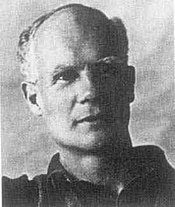Egon Pearson
Egon Pearson | |
|---|---|
 | |
| Born | Egon Sharpe Pearson 11 August 1895 |
| Died | 12 June 1980 (aged 84) |
| Nationality | British |
| Alma mater | University of Cambridge |
| Known for | Neyman–Pearson lemma |
| Spouses |
|
| Children |
|
| Parents |
|
| Awards | Weldon Memorial Prize (1935) Guy Medal (Gold, 1955) |
| Scientific career | |
| Fields | Statistics |
| Institutions | University College London |
| Doctoral students | George E. P. Box Bhaskar Kumar Ghosh Pao-Lu Hsu Norman Lloyd Johnson |
Egon Sharpe Pearson CBE FRS[1] (11 August 1895 – 12 June 1980) was one of three children of Karl Pearson and Maria, née Sharpe, and, like his father, a British statistician.[2][3]
Career
[edit]Pearson was educated at Winchester College and Trinity College, Cambridge, and succeeded his father as professor of statistics at University College London and as editor of the journal Biometrika. He is best known for development of the Neyman–Pearson lemma of statistical hypothesis testing. He was elected a Fellow of the Econometric Society in 1948.[4]
Pearson was President of the Royal Statistical Society in 1955–56,[5] and was awarded its Guy Medal in gold in 1955. He was appointed a CBE in 1946.
Pearson was elected a Fellow of the Royal Society in March 1966.[6] His candidacy citation read:
Known throughout the world as co-author of the Neyman–Pearson theory of testing statistical hypotheses, and responsible for many important contributions to problems of statistical inference and methodology, especially in the development and use of the likelihood ratio criterion. Has played a leading role in furthering the applications of statistical methods — for example, in industry, and also during and since the war, in the assessment and testing of weapons.[6]
Family life
[edit]Pearson married Eileen Jolly in 1934 and the couple had two daughters, Judith and Sarah. Eileen died of pneumonia in 1949. Pearson subsequently married Margaret Theodosia Scott in 1967 and the couple lived in Cambridge until Margaret's death in 1975. Pearson moved to West Lavington in Sussex and lived there until his death in 1980.[3]
Works
[edit]- On the Use and Interpretation of certain Test Criteria for the Purposes of Statistical Inference (coauthor Jerzy Neyman in Biometrika, 1928)
- The History of statistics in the XVIIth and XVIIIth centuries (1929). Commented version of a series of conference by his father.
- On the Problem of the Most Efficient Tests of Statistical Hypotheses (coauthor Jerzy Neyman, 1933)
- The Application of Statistical Methods to Industrial Standardisation and Quality Control. London: British Standards Institution, Publication Department. 1935.[7]
- Karl Pearson : an appreciation of some aspects of his life and work (1938)
- The Selected Papers of E. S. Pearson. Cambridge University Press. 1966.
- Studies in the history of statistics and probability (1969, coauthor Maurice George Kendall)
Collections
[edit]University College London holds the archive of Pearson, which was acquired in four separate accessions between 1980 and 2013.[8] The collection includes material relating to Pearson's professional life such as lecture notes, draft publications, correspondence and papers relating to the Biometrika journal.[8]
References
[edit]- ^ Bartlett, M. S. (1981). "Egon Sharpe Pearson. 11 August 1895-12 June 1980". Biographical Memoirs of Fellows of the Royal Society. 27: 425–426. doi:10.1098/rsbm.1981.0017. JSTOR 769879.
- ^ Egon Pearson at the Mathematics Genealogy Project
- ^ a b O'Connor, John J.; Robertson, Edmund F., "Egon Pearson", MacTutor History of Mathematics Archive, University of St Andrews
- ^ "Election of Fellows, 1948". Econometrica. 17 (1): 86. January 1949. JSTOR 1912138.
- ^ "Royal Statistical Society Presidents". Royal Statistical Society. Archived from the original on 17 March 2012. Retrieved 6 August 2010.
- ^ a b "Lists of Royal Society Fellows 1660-2007" (PDF). London: The Royal Society. Retrieved 1 May 2011.
- ^ Rietz, H. L. (1936). "Review: The Application of Statistical Methods to Industrial Standardisation and Quality Control by E. S. Pearson" (PDF). Bull. Amer. Math. Soc. 42 (9): 617–618. doi:10.1090/s0002-9904-1936-06365-2.
- ^ a b UCL Special Collections. "Egon Sharpe Pearson Papers". UCL Archives Catalogue. Retrieved 15 May 2024.
External links
[edit]- Egon Sharpe Pearson Papers held at University College London
- Obituary by Herbert A. David (retrieved 1 August 2017)
- Obituary by J. J. O'Connor and E. F. Robertson (retrieved 1 August 2017)
- 1895 births
- 1980 deaths
- People from Hampstead
- Alumni of Trinity College, Cambridge
- Academics of University College London
- Commanders of the Order of the British Empire
- English mathematicians
- English statisticians
- Fellows of the Royal Society
- People educated at Winchester College
- Presidents of the Royal Statistical Society
- 20th-century British mathematicians
- Fellows of the Econometric Society
- British mathematical statisticians
